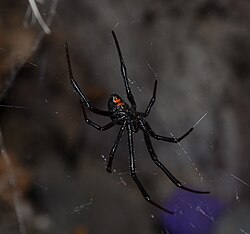Black Widow Spider
| Latrodectus | |
|---|---|
 |
|
| Scientific classification | |
| Kingdom: | Animalia |
| Phylum: | Arthropoda |
| Subphylum: | Chelicerata |
| Class: | Arachnida |
| Order: | Araneae |
| Infraorder: | Araneomorphae |
| Family: | Theridiidae |
| Genus: |
Latrodectus Walckenaer, 1805 |
| Species | |
|
31 described species, estimated 65 species living |
|
31 described species, estimated 65 species living
Latrodectus is a genus of spiders in the family Theridiidae, most of which are commonly known as widow spiders. The genus contains 31 recognized species distributed worldwide, including the North American black widows (L. mactans, L. hesperus, and L. variolus), the button spiders of Africa, and the Australian redback spider. Species vary widely in size. In most cases, the females are dark-colored and readily identifiable by reddish hourglass-shaped markings on the abdomen.
The venomous bite of these spiders is considered particularly dangerous because of the neurotoxin latrotoxin, which causes the condition latrodectism, both named for the genus. The female black widow has unusually large venom glands and its bite can be particularly harmful to humans. However, despite the genus' notoriety, Latrodectus bites are rarely fatal. Only female bites are dangerous to humans.
Female widow spiders are typically dark brown or a shiny black in color when they are full grown, usually exhibiting a red or orange hourglass on the ventral surface (underside) of the abdomen; some may have a pair of red spots or have no marking at all. The male widow spiders often exhibit various red or red and white markings on the dorsal surface (upper side) of the abdomen, ranging from a single stripe to bars or spots. Females of a few species are paler brown and some have no bright markings. The bodies of black widow spiders range from 3 to 10 mm in size, some females can measure 13 mm in their body length.
The prevalence of sexual cannibalism, a behavior in which the female eats the male after mating, has inspired the common name "widow spiders". This behavior may promote the survival odds of the offspring; however, females of some species only rarely show this behavior, and much of the documented evidence for sexual cannibalism has been observed in laboratory cages where the males could not escape. The male black widow spiders tend to select their mates by determining if the female has eaten already to avoid getting eaten themselves. They are able to tell if the female has fed by sensing chemicals in the web.
...
Wikipedia
